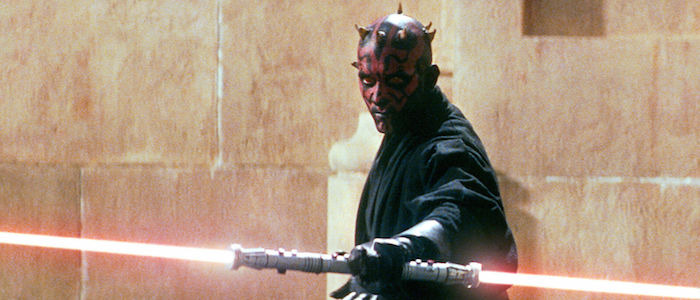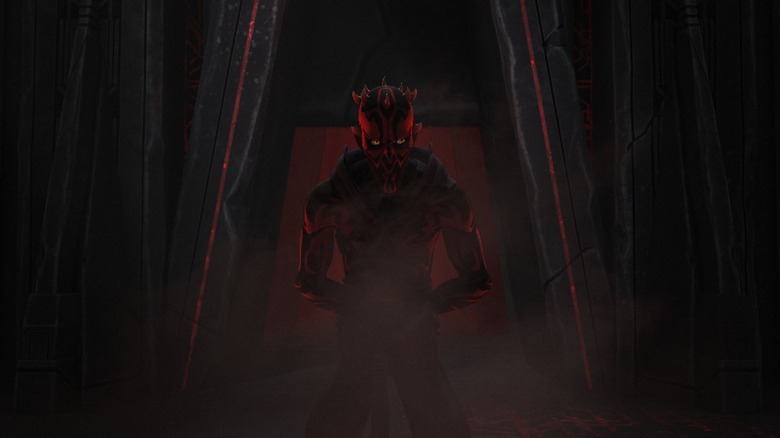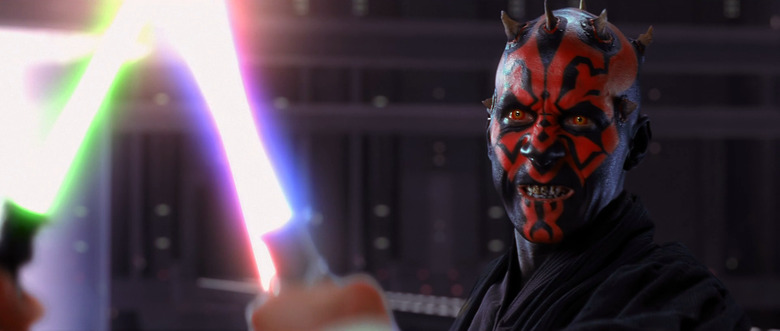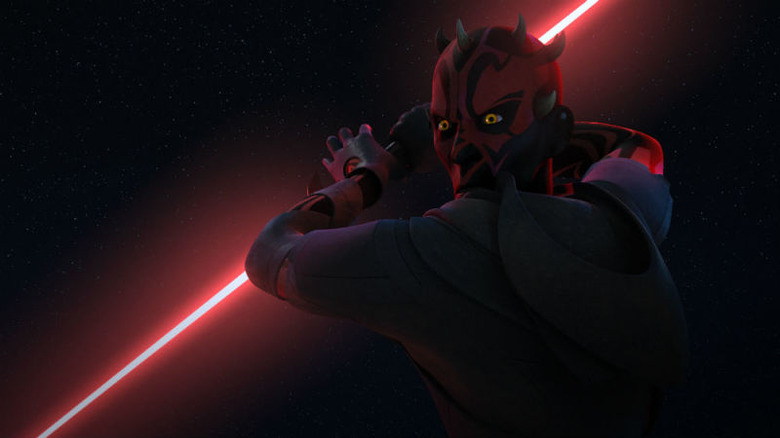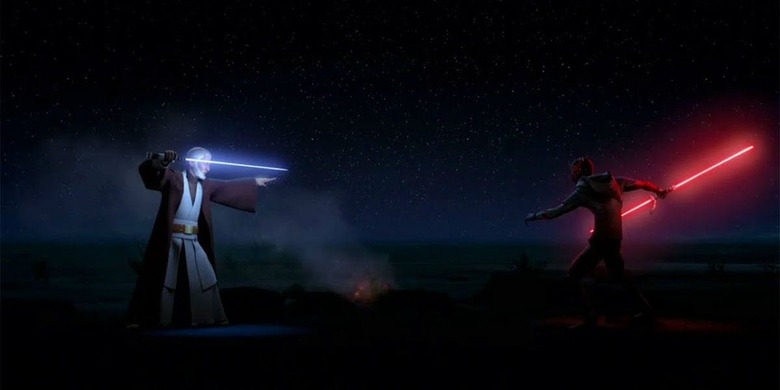Let's Talk About That Huge Reveal In 'Solo: A Star Wars Story'
This article contains major spoilers for Solo: A Star Wars Story. If you haven't seen the movie, turn right around and walk way. Trust us. This will be waiting for you later.
Seriously. This is your last spoiler warning. Scroll down for more.
Return of the Sith
When it is revealed near the end of Solo: A Star Wars Story that Maul was alive and operating in the underworld, it is a shocking revelation. For fans who haven't kept up with the ancillary material, Maul's appearance is as big of a twist as finding out that Darth Vader is Luke's father. For those of who have kept up, though, the reveal wasn't expected, but it certainly made sense. Then, when you add up all of the clues leading up to it, it was brilliantly foreshadowed.
We're going to dive into the story clues from the ancillary material to catch you up on everything you need to know to understand exactly where Maul fits into the continuing stories of Star Wars, post-Phantom Menace.
Maul’s Survival
The first question audiences unfamiliar with the larger Star Wars canon will ask is, "Wait! How did Maul survive?"
The answer to that question comes from Star Wars: The Clone Wars, the animated show that ran from 2008 to 2015. In the fourth season, Maul's brother, a Dathomiri Zabrak named Savage Opress (voiced by Clancy Brown), discovers that Maul was still alive. Since Opress was on the run from the Sith after a brief stint as Count Dooku's apprentice, he goes on a quest to find his brother, who had long been thought dead. Eventually, he finds Maul living (barely) on Lotho Minor, a planet-sized garbage dump. It turns out, after his defeat at the hands of Obi-Wan Kenobi on Naboo, he was taken out in the trash and managed to survive, fueled only by his hatred and the dark side itself.
Over the years, living in the trash, Maul somehow cobbled together massive spider-legs and his horns grew out like deer antlers. But his mind also broke. When Savage found Maul, he was little more than a raving lunatic.
With the help of their mother, a powerful Witch of Dathomir, they were able to clear Maul's mind and bring him back to a more recognizable state. She also replaced his spider-legs with more human bionic legs, very much like the ones we see in Solo: A Star Wars Story.
Control of the Underworld
When Maul — no longer known as "Darth" as he was no longer a Sith apprentice — realized he'd been left behind in his former master's plans to start the Clone War, he decided he wanted to create his own front in the war to carve out power for himself. To this end, he created what he would call The Shadow Collective. This collective rounded up all of the major criminal syndicates by force, including Black Sun and the Hutts, and forced them to participate in his plan to take control of Mandalore. Maul's chief ally in this fight was Pre Vizla, a disaffected Mandalorian and head of Death Watch (voiced by Solo's Jon Favreau). After Maul gained control of Mandalore, Darth Sidious realized that his former apprentice was enough of a problem that he needed to be dealt with permanently. Sidious arrived on Mandalore and, in an epic lightsaber duel, killed Savage and captured Maul.
In the canon comic book Darth Maul: Son of Dathomir, we discover that Sidious kept Maul alive in order to draw out his mother and kill her. Although Sidious did end up killing Mother Talzin, Maul escaped once more, but watched many of the alliances in his criminal empire dissipate. It was at this time, the Pyke Syndicate left Maul's Shadow Collective.
Connecting the Dots
When you connect the dots of this story, you realize that Maul was the only person that could have been revealed to be the head of Crimson Dawn. Given the timeline and where we last saw Maul, the film lays careful groundwork to let us know to expect Maul.
The name Crimson Dawn itself could be a reference to his lightsaber color or even the red tattoos on Maul's face. When Dryden Vos (Paul Bettany) explains the fragile peace between Crimson Dawn and the Pyke Syndicate, it's an oblique reference to this falling out that Maul had with the Pykes in that comic book. You can see a Pyke running the spice mines of Kessel and get taken out by Qi'ra.
Now we know that Maul maintained his control over parts of the underworld after being run into hiding by Darth Sidious and let that blossom into what would become Crimson Dawn.
There were other clues as well. In what might have seemed like a random mention of a video game on Qi'ra's part in Solo was actually a carefully laid clue about the identity of Dryden Vos's master. She mentions that Dryden Vos taught her the art of Teras Kasi, which was the fighting style created for the 1997 Star Wars fighting game Masters of Teras Kasi. In Legends novels featuring Maul, he himself was a student of the ways of Teras Kasi. So when you think that Dryden taught Qi'ra and you wonder where he learned it, Maul is the most likely answer.
Beyond Solo
But what happens next? Well, there's still a sizable gap in the timeline between Solo and when we pick up Maul's thread in the second season of the other animated series, Star Wars Rebels, which continues (and concludes) Maul's story. There are still Maul stories to be told in this era, even if we witnessed his end on the animated series.
But we do know that the lightsaber he wields in Solo is the same one that he's stranded on the planet Malachor with. It's there that he's found by Ezra Bridger and Ahsoka Tano and he actually helps them fight off Sith Inquisitors before turning on them and trying to claim Bridger as his own apprentice. Eventually, the show brings his story to a final close once and for all in an episode called "Twin Suns," which is one of the best television installments of Star Wars ever made.
(For a more in-depth dive into this, check out this episode of the Fauxthentic History podcast, where I broke Maul's life down with Holly Frey of Stuff You Missed in History Class.)

